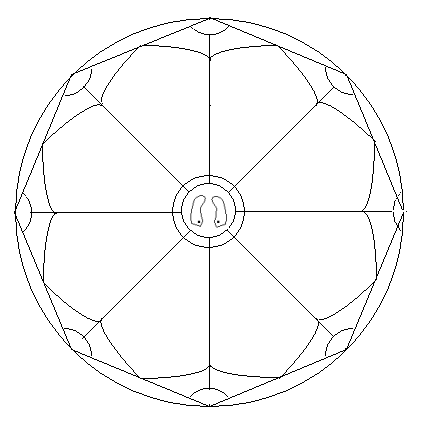Index - Tens:
01
02
03
04
05
06
07
08
09
10
11
12
13
14
15
16
17
18
19
20
21
22
23
24
25
26
27
28
29
30
31
32
33
34
35
36
37
38
39
40
41
42
43
44
45
46
47
48
49
50
51
52
53
54
55
56
57
58
59
60
61
62
63
64
65
66
67
68
69
70
71
72
73
74
75
76
77
78
79
80
81
82
83
84
85
86
87
88
89
90
91
92
93
94
95
96
97
98
99
100 ::
Matrix of Artistry (Chitra Paddathi)
Chitra Paddathi - Tuesday Yanthram
940
SaakEtha ThrANa vELAjanitha tathanijaprAngaNa SrIprabhAsA
SaabhA prasrIDavyAm iyamamama yamivyApadhucchEdhilAsA
SaalAdhicchEdha tigmA havarururu vaha hrIkarasyAmarAsA
asaa RaamasyAngrimapyAjati na na nathijasTUlamuthrAtakE Saa
See also Lotus Chakram

Meaning & Details
We go back to the times, when PaadhukA was ruling over
AyOdhyA seated in the royal court, it spread its
splendid effulgence over the whole courtyard- its
effulgence of Pure Knowledge, effulgence of its
gratness and fame. The hall is filled with Vedic
effulgence and is capable of rooting out all foes, that
too in a sportive manner in the case of sages, who have
totally banished conceit nd perception and removing the
tendency to indulge in idle prattle. As Raama, as in
this Vishnu form, He extracted the "essence" of the
foe, that is, haughtiness and bow (weapon) of the foe.
As the fierce fight was going on, it caused a sense of
shyness, modesty and defeat, when Raama's elbow power
became evdent. The PaadhukAs of that Lord recommends
the poor, pitiable, people needing help, who bow to the
LOrd in abject surender to the feet, Which shines in
exhiliration.
Special Notes by V. Sadagopan:
This slOkam is set in Kavi nAmAngitha ashta dhaLa
padhma chithram. This includes a lotus chakram with the
name of the poet, who composed this brilliant kAvyam
(Venkatapathi Kamalam). Venkatapathi is the other name
for VenkatanAthan (Swami Desikan), the author of this
brilliant kAvyam. The ladies of the house for worship
use this slOkam on TUESwami DesikanAYS. This slOkam is
in SragdharA metre and each paadham has 21 aksharams:
sAkEtha thrANa vELAjanitha tathanijaprAnkaNa SrIprabhAsA
sAbhA prasIDavyAm iyamamayamivyApathus-cchEdhilAsA
sAlAdhicchEdha tigmaa havaruru vaha hrIkarasyaamarAsA-
saaRaamasyAngrim abhyajAthi na na nathijasTUlamuthrAtakE
1.UtthamUr Swami's anubhavam: This slOkam celebrates
SrI RaamachandrA and His glorious deeds through the
salutation to SrI Raama PaadhukAs. The slOkam says:
"SrI Raama PaadhukAs have a natural lustre. They are
known for the fact that the VedAs eulogize them. At
TaatakA forest, these PaadhukAs removed the danger that
the egoless yOgis faced. Later, when they ruled over
AyOdhyA and protected the citizens, the sound that they
made created a glow around them. They remove the
sorrows of those who have not perfected their sense of
true knowledge. These are the PaadhukAs of SrI RaamA,
who defeated Rudra in war and which broke the bow of
Siva at Mythilai. They made RudrA holding a deer in His
hand feel ashamed over his defeat. These are the
PaadhukAs commanded by Raama to rest on the heads of
His devotees. They also make it possible for RaamA's
sacred feet to approach their heads. They destroy
asubha sankalpams.
2. Srimath Andavan's anubhavam: In the 934th slOkam,
the focus was on how the Paadhukais destroy the sins of
Paapis through some vyAjam (excuse) and uses their
PurushakAram with the Lord to accomplish that act.
Next, the Vaathsalyam for aasritha Janam, nithya yOgam
with the Lord were described. That was followed by the
examples of upakArams along these lines such as
ViswAmithra Yaaga SamrakshaNam. Next the acquisition of
bhagavath guNams by the Paadhukais due to Bahgavath
sambhandham was described. Now, the description of the
samrakshaNam of MahA Paapis by the Paadhukais is
continued. SaraNAgatha samrakshaNam as Sarva Saasthra
Saaram is the theme here again. The PurushakAra
kaashtai of the Paadhukais in persuading the Lord to
protect the saraNAgatha jeevans is described.
3. The division by padhams (16 units) of this long slOkam is as follows:
a) SaakEtha ThrANa vELA janithatha nija prAnkaNa Sri PrabhAsA: During its
PaadhukA Raajyam at AyOdhya for 14 years, the Paadhukais had the glorious
effulgence arising from their gold and gems as they sat on the throne of Raghus
in the middle of the raaja sabhai full of great-learned souls.
b) SaabhA: they possessed Kaanthi (Keertthi shObhitham) then.
c) prasree: the Kaanthi arose from the eternal Veda Sampath (SaamAnya & Sookshma Jn~Anam.
d) aDavyAm: In the TaaDakA Vanam (during Yaj~na rakshaNam).
e) Iyam: This Raama PaadhukA
f) amamayamivyApadhucchEdhithalaasA (amama +yami + vyApath+ ucchEdhi +laasA):
That PaadhukA with the playful acts of protecting the egoless yOgis from
dangers that confronted them in the TaDakA forest .
g) Saaladhi-cchEdha thigma aahava ru hUm ruru vaha hrIkarasya: These PaadhukAs
of the Lord with its power made Rudra --with the mark of deer in his hand--
flee the battle field through their hUmkAra sabdham.
h) AamarAsasA: Those PaadhukAs, which removes the ignorant words and creates the good tatthva Jn~Anam in aasrithAs.
i) Raamasya: Those PaadhukAs belonging to VishNu Roopi, Raaman.
j) angrim: of the sacred feet of the Lord
k) (angrim) abhyajAthi na: The Paadukais recommend to the Lord's feet to accept
the aasrithan as an object of protection. (l, m , n) nathijasTUlam +utthrAtakE+
Saa: After seeing the bowed head seeking protection, the Lord's sacred feet
are swollen with joy about SaraNAgatha SamrakshaNa laabham (gain) .This results
from the PurushakAram (intercession) of the dhivya PaadhukAs.
